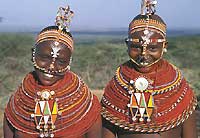| Period: 3
August - 22 October
2004. Country: Kenya |
|
(1) Anthropological Study
on Changes in the Age System and Body Adornments of the Samburu, a Pastoral People
in Northern Kenya |
| NAKAMURA
Kyoko (Division of African Area Studies) |
| Key Words: Moran (Warrior), Beaded Adornments, Social Change, Market Economy, Social Identity |

Samburu unmarried girls: They were given these huge amount of beads by their boyfriends, moran |
(2) The main objective of this study is to clarify the dynamics of the age system, a central social system of the Samburu. I made use of changes in body adornments as a key clue toward this work.
The Samburu age system
divides all the men of the society into three age-grades: "boyhood" (from
birth to initiation), "moran-hood" (from initiation to marriage),
and "elderhood" (after marriage). I focus mainly on the "moran," who
are initiated, and in the status of prolonged adolescence, because their marriage
is socially postponed. Body adornments indicate a person's social or ritual status,
and the transfer of adornments establishes a social relationship between the
giver and the recipient. In particular, the moran wear many beaded adornments,
and in recent years these adornments have become increasingly flamboyant and
eye-catching.
This study examines
changes in the adornments in relation to the new experiences of the moran under
such modern conditions as school enrollment, migrant work, tourism, and the market
economy, and analyzes what changes have been effected to the age system.
(3) Moran decorate
not only themselves but also their girlfriends with beads. When a girl is
given the beads by a moran, she becomes a socially approved girlfriend.
In order to clarify the details of this relationship (beads-relation, hereinafter),
and compare it with marriage, I conducted fieldwork from 15 August to 10
October 2003 in Samburu District, and gathered many cases of beads-relations,
and cases of moran's affrays over girlfriends. I also transcribed
and analyzed many songs which moran sing on different occasions.
Beads-relationships
are similar to marriage in some aspects; the couple has an exclusive and long-term
sexual relationship, and it creates specific social relations between the moran and
his girlfriend's mother, and between the moran and his girlfriend's
sisters. Despite these similarities, beads-relations are completely different
from marriage, because moran choose their girlfriends usually within their own
clan, which is an exogamous unit. It differs from marriage also because unmarried
and uncircumcised girls are not allowed to give birth. A striking difference
between the sexuality of the unmarried and the married was discovered. As the
recent phenomenon it was also shown that the number of unmarried mothers is increasing,
and that moran increasingly choose their girlfriends from different clans.
On my way back to
Japan I stayed in London for a week and visited the Royal Anthropological Institute, the Royal Geographical Society and Dr.Paul Spencer who had studied among the
Samburu from 1957 to 1976 to collect photographs of the Samburu taken mainly
during the colonial period. I will use these photos to clarify the historical
changes in Samburu adornments, in relation to the important events that they
encountered; participation to the Second World War as soldiers of the Kenya Army,
school enrollment, migrant work in towns or beach resorts, and the establishment
of the cattle market in Samburu.
|

 21st Century COE Program
-Aiming for COE of Integrated Area Studies-
21st Century COE Program
-Aiming for COE of Integrated Area Studies-